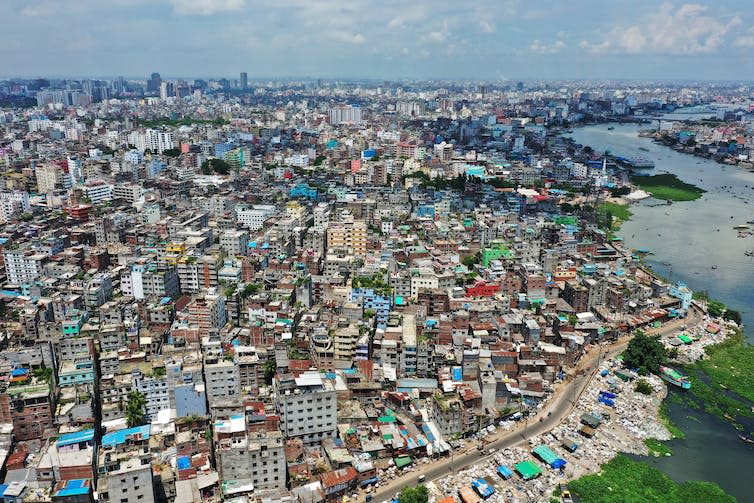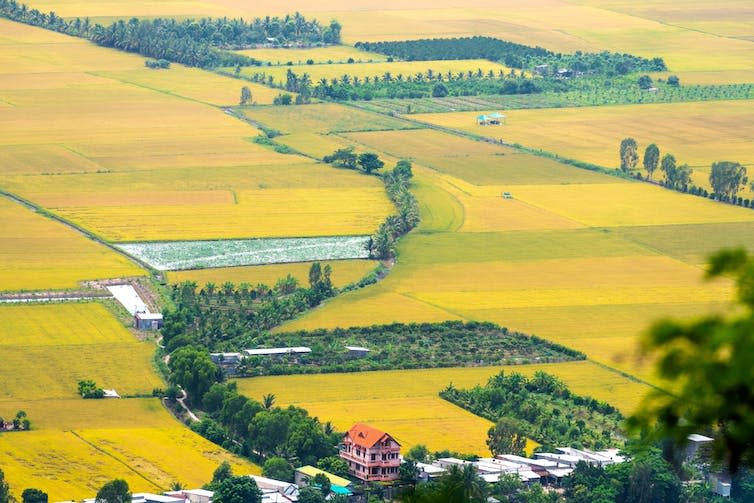Coastal river deltas and their population of nearly half a billion are in a precarious position between rising sea levels and upstream pressures. These regions have played an important role in social development since the last ice age, offering flat, fertile lands with abundant fresh water, ideal for agriculture.
Coastal river deltas have recently become centers of global maritime trade, giving rise to rapidly growing megacities such as Dhaka, Cairo and Shanghai. However, these areas are now under threat. And the blame can’t all be placed on climate change.
Our latest research finds that 49 deltas around the world, including the Nile, Mekong and Mississippi, face increasing risks under all of the IPCC’s future scenarios for climate change and development.
Our analysis shows that some risks are more critical for some deltas than others. These risks include land subsidence, increasing population density, intensive agriculture, ineffective management and lack of adaptive capacity.

sinking land
Effects such as sea level rise and related salinization are a significant threat to deltas. But it is not just the rising sea that creates such risks; deltas are also sinking. Our results show that land in deltas such as the Mekong in Vietnam and the Krishna and Godavari in India is declining three times faster than sea level rise.
As the earth’s crust gradually changes shape, all land rises and falls. However, when the soil consists of sediment piles hundreds of meters deep, as in some deltas, the process can occur much faster. Sediment particles are compressed under the weight of whatever is above them (including cities), and when water, and sometimes oil and gas, that naturally fills the spaces between the particles is pumped out, the grains collapse on top of each other.
Land subsidence causes relative sea level rise (combination of sea level rise plus land sinking). This process can make cropland saline, cause widespread flooding and, in extreme cases, lead to the loss of entire coastal areas. Research shows that approximately 25 percent of Jakarta, the capital of Indonesia, which is built on low-lying land next to the sea, will be under water in 2050.
Population density and crop land use
The Nile, Ganges and Pearl deltas are among the most densely populated places in the world. China’s Pearl delta, in particular, is full of megacities such as Guangzhou, Dongguan and Foshan, which together are home to more than 30 million people. Many deltas will become more densely populated and urbanized in the coming decades.
Urban development prevents natural river floods from carrying sediment into the deltas and maintaining the land’s elevation above the river channel and the sea. This could cause delta land to sink even faster relative to sea level.
Deltas are also very important for food production. Irrigated agriculture covers almost all of the Red Delta in Vietnam, the Po in Italy and the Yangtze in China. If groundwater is pumped from groundwater to irrigate crops, these deltas will again decline much more rapidly.
Disruption of food production in these places could have dire consequences in the future; And not just for delta residents. Vietnam is the world’s second largest rice exporter, and almost all of this rice comes from the Mekong delta.


Adaptive capacity
Delta countries have options for managing many of the risks they face; These countries are not just at the mercy of major global greenhouse gas emitters. However, in many deltas the preparedness, capacity and effectiveness of governments to adapt to risks is low.
This is especially true for the Irrawaddy delta in Myanmar and African deltas including the Congo, Limpopo and Zambezi. The per capita GDP of countries in these deltas is among the lowest in the world, as are indicators of government effectiveness and readiness to adapt.
International support and cooperation can and should play a supporting role here. But this is not a simple task. Developing countries require significant financing to implement the necessary adaptation measures. In fact, the adaptation finance needs of developing countries are now ten to 18 times greater than international public finance flows (funds that typically move between countries to support development).
And that’s just to adapt to climate change. The array of delta risks our analysis reveals extends well beyond climate and requires coordination from local to global scales.
What’s the solution?
Solutions that take all these risks into consideration should be developed. Efforts to limit climate change remain urgent, as do regulations on groundwater and fossil fuel extraction from deltas.
Cities can be designed to be more resilient to floods, and agricultural practices can be adapted to cope with the risks. This may include adopting methods such as aquaculture, growing salt-tolerant crops, or exploring alternative agricultural approaches that can accommodate flood and delta sedimentation processes.
Read more: Climate change is making soils saltier, forcing many farmers to find new livelihoods
Engineering solutions such as seawalls will be necessary where other strategies are impossible. However, these should not become the default approach. Above all, the development of solutions must be inclusive, involving not only experts but also local people, and supported by urgently needed government action and funding.
This article is republished from The Conversation under a Creative Commons license. Read the original article.


Murray Scown receives funding from the Swedish Sustainable Development Research Council (Formas).
Frances Eleanor Dunn does not work for, consult, own shares in, or receive funding from any company or organization that would benefit from this article, and has disclosed no relevant affiliations beyond her academic duties.